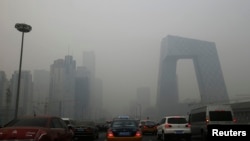In the summer of 2008, Chinese authorities took various steps to reduce air pollution as Beijing hosted the Olympic Games.
University of Rochester professor David Rich said that "in the years before and after the games, pollution levels were about twice as high as they were during the games, a third [higher] to twice as high. You go from a very heavily polluted city to an only moderately polluted city.”
Rich said that temporary improvement in air pollution gave him and his colleagues the opportunity for what is called a natural experiment. Using records of tens of thousands of births, they compared the birth weights of babies born during the Olympic summer with those born at the same time the year before and the year after.
The most striking finding focused on air pollution exposure near the end of pregnancy.
“When your air pollution level increases during the eighth month of pregnancy, you saw a decrease in birth weight," Rich said. "And when your eighth month of pregnancy was during the Olympic games, when air pollution levels were lower, you saw an improvement in birth weight.”
Low birth weight is considered an important marker of an infant’s health. Low birth weight babies are more likely to have developmental problems as children, and may be at a higher risk for conditions such as heart disease in later life.
It’s unclear why air pollution is related to low birth rate, especially when that exposure is in the eighth month of pregnancy. Rich said one theory is that the pollution causes inflammation in the mother, which limits nutrients reaching the fetus at a time it's developing rapidly.
Regardless of the mechanism, the researcher said, his study has an important public health message.
“Yes, this is a highly polluted city, and yes, the pollution levels came down drastically," Rich said. "But imagine what could happen if in fact we reduced these pollution levels on a more permanent basis.”
The study by Rich and his colleagues is published in the journal Environmental Health Perspectives, which is supported by the U.S. National Institute of Environmental Health Sciences.












